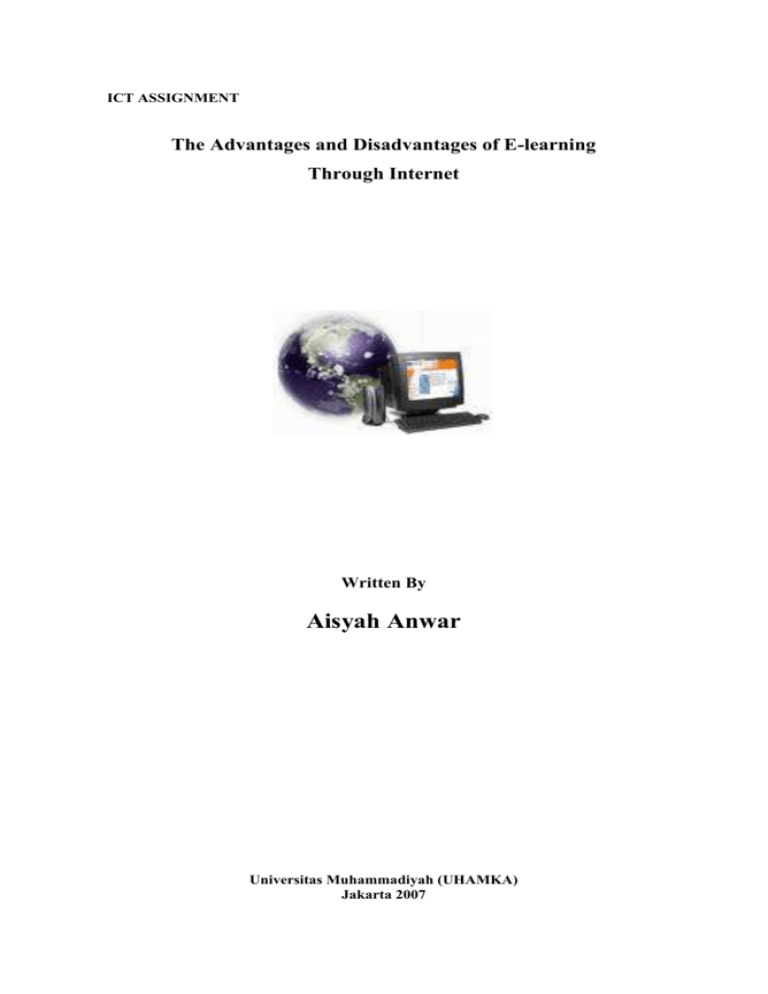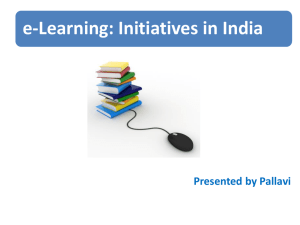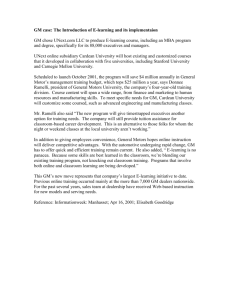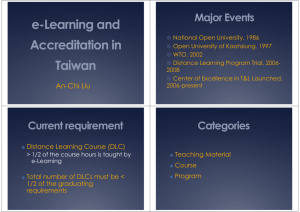Do you want to learn through electronic media
advertisement

ICT ASSIGNMENT The Advantages and Disadvantages of E-learning Through Internet Written By Aisyah Anwar Universitas Muhammadiyah (UHAMKA) Jakarta 2007 The Advantages and Disadvantages of E-learning Through Internet Do you want to learn through electronic media? If your answer is yes, you have to learn more about computer and internet. Before pursuing my explanation concerning with e-learning, let me explain briefly the followings. 1. What is e-learning ? According to Allan. J. Henderson, e-learning is long distance learning using computer technology or using internet (The e-learning question and Answer Book, 2003). Henderson also conveyed that e-learning enables learners to learn through computer in their places without their presence in class. William Horton explained that e-learning is a learning based on web that can be accessed from internet. Learners can be in Jakarta, while the instructor in other cities or even in other countries. Yet interaction can be done directly. Learners can study from home or in the office connected with internet. Learning material is managed by a company in United States of America, Japan, and England. Learner can arrange the time and places when and where they want to access the information through internet. Learning with electronic media which is famous for electronic learning informed through electronic media connected with internet (World Wide Web) which connects all computer units in the world with internet and intranet. If you have computer connected to internet, you can participate in e-learning. So, learning using high technology will accommodate chance a number of great learners comparing with a number of students in class. This technology also enables learners gaining lessons with standard quality than gaining the lessons in class which depend on the mood and physical condition of the instructor. In e-learning the same module (information, performance, and learning qualities) can be accessed in the same form by all learners who access it, while conventional learning in class, due to the health reasons and individual problems, one instructor can give lesson in several classes with different qualities. According to Jay Cross, information architect of Internet Time Group, "e-Learning" is the target model for corporate training in the next three to five years. It will be a key survival skill for corporations and free agent learners and is a convergence of: loosely organized corporate ecologies a business climate of permanent white water technological advances, including high-speed broadband networks a shift of power and responsibility from organizations to individuals emergent best practices, from performance support to training to knowledge management. Says Cross, "Successful leaders inspire members of their organizations to work smarter. Collaboration, learning portals, and skill snacks have replaced Industrial-Age training. The Web is revitalizing personalized learning and meaningful apprenticeship. Learning is merging with work." Here's what lies ahead in our not-too-distant training future, according to Cross: personal software agents that crawl the Web to screen and feed information to personal portals connected gadgets and gizmos that simplify (and complicate) our lives plug-and-play training modularity learning standards that create interchangeable, Lego-like objects that slash costs and development time. 2. What is the use of E- Learning for you The more company and individual use e-learning as a media for training in education, the more the e-learners have experiences in utilizing computer or internet. Learners benefit learning based on the this web. From various commands, there are three similarities in utilizing e-learning. Flexibility. In conventional class it is a must for learners to be present in class in particular hours (very often this period overlap with learners outside activity). E-learning give flexibility in determining schedule, places to access the lesson. Learners don’t need to spend more times to go school. E-learning can be accessed from anywhere which has internet access. Even with technological mobile (Palmtop or a particular celular phone) it is easier to access e-learning. Many public places provide free of charge internet connection such as : in airport and cafes. While you area having trip or waiting for lunch, you still can make use of the time to access internet Independent learning E-learning gives opportunity for learners to manage everything for individual learning success. Learners are given freedom to determine when to stop learning and when to finish and which one should be learned first. They can begin from the topic based on their interest or leave some topic which they have already mastered. If they have difficulties in a certain topic, they can repeat till they understand it. If they still don’t understand they can contact the instructor through email or join interactive dialog at a certain time. In case they cannot join interactive dialog, they still can read the result of discussion on board message provided at LMS or in website. Many people feel this independent learning is more effective than forcing learners to learn with a certain arrangement. Cost Learning through internet is not costly. The cost cited here is not only financial cost, but also non financial cost. Financially, the cost can be saved such as transportation up to the destination, the cost for administration such as : salary during training, the cost for instructor, administrator or food during media preparation and physical facilities for learning such as renting the class, chairs, white board, LCD player, and OHP. 3. How to benefit e-learning optimally E-learning can benefit to use if the requirement is met. The following requirement are : PURPOSE. Before joining e-learning you have to determine you learning purpose. You can choose the topic, module, the length of time for learning, cost and learning media using electronic devices. This purpose should be dealt with your individual or business purposes specifically and manageable. LEARNER. E-learning gives opportunity to be independent learners. So, to get the optimal advantages of e-learning, you have to enjoy learning independently, have positive attitude toward learning, have motivation to master the topic taken. Learning is not a burden, but a chance to increase qualities. You should have discipline in learning, and have devices to support you such as computer, internet access, printer, skill and strategy to learn independently in mirage world (The basic skill to utilize computer and internet and strategy to manage the time). SUPPORT. Support from nearest people are needed badly such as manager, the company, office mates, friends, and family. Having support from the nearest people will increase their spirit in learning. OTHER MEDIA. E-learning is only a device to attend the goal. So, e-learning should not be used originally, but it can be harmonized by using other media to reach the success of the learners The advantages and the disadvantages of e-learning through internet. There area many advantages and disadvantages of e-learning. But now we are only focusing on the “the advantages and disadvantages of e-learning through internet”. To know more about the benefit of e-learning in general, let’s read some information written by Kevin Cruse : The vast movement towards e-learning is clearly motivated by the many benefits it offers. However much e-learning is praised and innovated, computers will never completely eliminate human instructors and other forms of educational delivery. What is important is to know exactly what e-learning advantages exist and when these outweigh the limitations of the medium. Features Unique to e-Learning Like no other training form, e-learning promises to provide a single experience that accommodates the three distinct learning styles of auditory learners, visual learners, and kinesthetic learners. Other unique opportunities created by the advent and development of elearning are more efficient training of a globally dispersed audience; and reduced publishing and distribution costs as Web-based training becomes a standard. E-learning also offers individualized instruction, which print media cannot provide, and instructor-led courses allow clumsily and at great cost. In conjunction with assessing needs, e-learning can target specific needs. And by using learning style tests, e-learning can locate and target individual learning preferences. Additionally, synchronous e-learning is self-paced. Advanced learners are allowed to speed through or bypass instruction that is redundant while novices slow their own progress through content, eliminating frustration with themselves, their fellow learners, and the course. In these ways, e-learning is inclusive of a maximum number of participants with a maximum range of learning styles, preferences, and needs. Collaborative Learning All collaborative learning theory contends that human interaction is a vital ingredient to learning. Consideration of this is particularly crucial when designing e-learning, realizing the potential for the medium to isolate learners. With well-delivered synchronous distance education, and technology like message boards, chats, e-mail, and teleconferencing, this potential drawback is reduced. However, e-learning detractors still argue that the magical classroom bond between teacher and student, and among the students themselves, can not be replicated through communications technology. Kevin divided three distinct learning styles (Auditory learners, visual learners, and kinestetik learners). Auditory learners are learners who can understand the lesson easily by listening and Visual learners are learners who can understand the lesson well by seeing the teachers explaining the lesson while the kinesthetic learners are learners who can understand the lesson by seeing the teachers movement, animation or pictures on TV. So, according to Kevin Internet can accommodate all learning styles. ADVANTAGES The Advantages of e-learning for the teachers Reduced overall cost. Teacher don’t need much money for going to warnet to make preparation in teaching. They can use school computer or internet financed by the government, design the lesson which can attract the student attention by using sophisticated technology which can give good challenge for them. Learning time Reduced. Imagine before we know computer or internet Student learn without utilizing this devices and all are done manually. Doing learning activities manually will spend much time. Let’s count how much time should the student spend to follow the lessons from elementary school until they study in university or join company training . Save energy in class. Teachers don’t need to give the note on white/blackboard. Using chalks or markers containing chemical substances from their dust and ink can endanger their health especially the lungs. They can just sit and stand by looking at the points appear on the screen of In focus while explaining them to their student. Writing on board takes a long time and makes them so exhausted. Teacher also have much time to control their student’s activity. Standardized Material. Learning materials given at school are various (materials, curriculum, version even the depth of material). Sometimes the way of teachers explain the lesson differs each other from other schools which makes them unsatisfied with the lesson presented. By e-learning standardized material learners can get material precisely the same as the original source. It depend on the learners how they understand the material. Deepening this material can be done through discussion or comparing with the same materials form other countries that can be obtained by e-learning. Automatical Administration. Designing e-learning accurately from analysis up to implementation will be helpful in administrating accurately. Students can see their assignments, the result of the try out, the statistics available at e-learning which can be read by the learners clearly. They can also monitor them, make and convey materials. In e-learning everything should be done in a good order to increase their achievement which is not difficult to gain. Easy ways to access information. Teacher can access other information automatically from internet. Based on my interview with Mr. Tarsono, the Biology Teacher at SMA N 72 held on December 10, 2007 saying that teaching using e-learning through internet motivates students more then using conventional one. He uses colorful pictures and animation which can raise learners interest to know more in detail about blood circulation, digestion, and internal body organ. Another interview was done to One of the student from Institute of Agriculture Bogor, Dwi Putri Novelia held on December 8, 2007 saying that using internet media will ease the students of IPB to get e-book (electronic book) about agriculture for example : How to cultivate the land, how to choose the best seeds, how to farm the livestock, how to make software and website at Computer Science Department without spending money for buying expensive book. Adaptation to Hi-Tech. Using e-learning will challenge the teachers in utilizing Hi-Tech. Based on my observation in my school most of young teachers have tendency to use Hi-Tech (Computer and Internet ) to help them put score through internet while a few old teachers still feel reluctant to use this media due to their incapability to operate computer and internet. Ease Presentation. E-learning can ease teachers in presenting their lessons. In conventional teaching, teachers should prepare teaching aids to attract the student’s attention. Nowadays, if the students wants to study about food for example McDonalds, Kentucky Fried Chicken, teachers don’t need to bring fried chicken to the class. If they want to show about Kentucky fried chicken they just click the button and a package of fried chicken along with the french fries and a glass of coke will appear on the internet screen. And even the historical background of these company can be browse through internet. Advantages of e-learning for learners Student do not only depend on the teacher in studying. Even when they are absent from class, they still have chance to study by accessing from internet Meaningful for slow and quick learners. For slow learners this e-learning activity will reduce stress because e-learning can accommodate them based on their ability, so there are no reasons to be shock and panic. For quick learners they can compete to gain their success by studying hard to satisfy their need. DISADVANTAGES The authenticity, educational productivity, and overall functionality and purpose of a virtual classroom is where key disadvantages lie for both teachers and students (Burbles, 2004, p.12). The chief disadvantage of the virtual classroom concerns the lack of face-toface interaction; one of the most important elements of a learning experience (Laurillard, 1993; Burbles, 2004). Some experts in the field of virtual classrooms and technology are concerned that the computer is replacing the “friendly face? of the teacher, and that human qualities are not maintained in the virtual classroom, which is a disadvantage to prospective students (Hall, 2005, para.11). Disadvantages of e-learning for Students For the student, several disadvantages exist in the virtual classroom. There are, according to Burbles (2004, p.5) “hidden barriers to access? of a virtual classroom to students; there are limitations of making an online course accessible to all. Some communication tools may not suit some students; for example, the streaming of audio cannot be heard by a hearing impaired student and thus this tool is not accessible to all. Another disadvantage of the virtual classroom is that it can only be successful if the communication tools used in the classroom are “in the student’s possession…accessible to the student… (and) operable by the student? (Lehmann, 2004, p.14). Although synchronous communication tools are usually perceived as an advantage because of their similarity to communication in the traditional classroom, they can also be a disadvantage. This is because they consist of real-time, text-based communication in which responses are often “out of sequence? as a consequence of varying typing abilities among students (Fetterman, 1998, para.7). The final disadvantages is lack of face to face interactions. The face to face interaction is important to see the learners attitude toward the lessons, the teachers can see whether their students pay attention to their lesson or just play together with their friends. By this interactions teacher are easy to control their student. Students must have adequate typing skills and communication skills as the majority of learning is text-based and self-paced, and if they are used to being in a structured, scheduled environment they will be disadvantaged and most likely get confused and fall behind (IOWA state University, 2001). Teachers are not as readily available in the virtual classroom as they are in the traditional classroom, therefore students who usually need continual support of the teacher may feel isolated, according to the IOWA State University (2001). Disadvantages of e-learning for Trainer or Organization E-learning is not, however, the be all and end all to every training need. It does have limitations, among them: Developing educational content Teacher find it hard to develop educational content which is interesting, relevan and important for student in an appropiate format or tool. They are challenged to develop content to suite a wider, more diverse class. There are also challenge to make the classroom inclusive and accommodate for convinience of the students (Burbles, 2004). If the syllabus of the traditional classroom is simply transported to the virtual classroom without modification to suite the online, environment, students and teachers are both disadvantages (Burbles, 2004). This is due to the chance to improve and modify the educational content according to the new outline format would be ruined (Burbles, 2004). Up-front investment required of an e-learning solution is larger due to development costs. Budgets and cash flows will need to be negotiated. Technology issues that play a factor include whether the existing technology infrastructure can accomplish the training goals, whether additional tech expenditures can be justified, and whether compatibility of all software and hardware can be achieved. Inappropriate content for e-learning may exist according to some experts, though are limited in number. Even the acquisition of skills that involve complex physical/motor or emotional components (for example, juggling or mediation) can be augmented with e-learning. Cultural acceptance is an issue in organizations where student demographics and psychographics may predispose them against using computers at all, let alone for elearning. Disadvantages to the Learner The ways in which e-learning may not excel over other training include: Technology issues of the learners are most commonly technophobia and unavailability of required technologies. Portability of training has become a strength of e-learning with the proliferation of network linking points, notebook computers, PDAs, and mobile phones, but still does not rival that of printed workbooks or reference material. Reduced social and cultural interaction can be a drawback. The impersonality, suppression of communication mechanisms such as body language, and elimination of peer-to-peer learning that are part of this potential disadvantage are lessening with advances in communications technologies.






